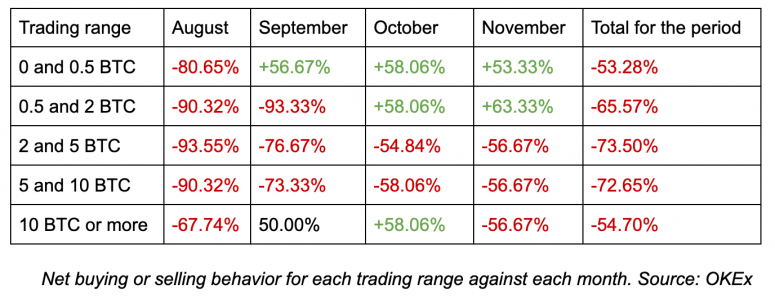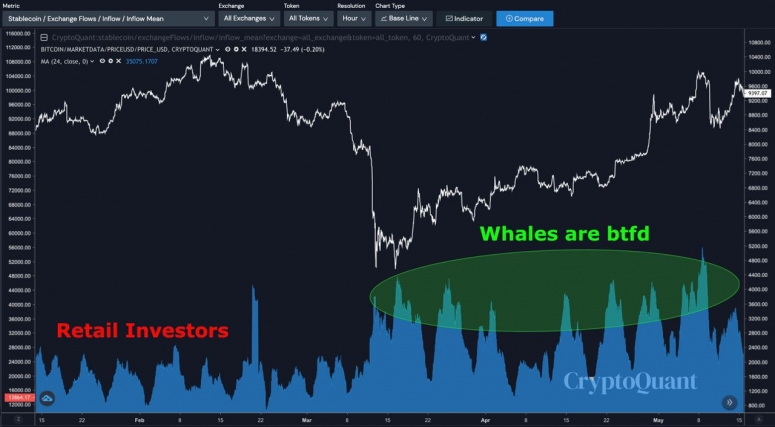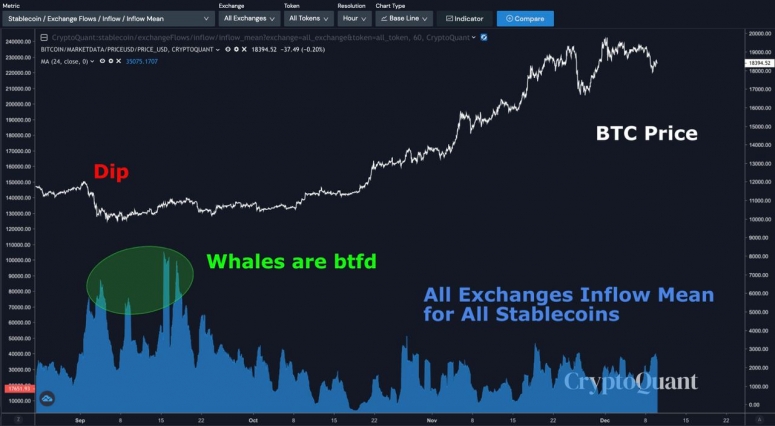Newly released data from crypto exchange OKEx gives one possible explanation of how larger holders of bitcoin – or “whales” – were able to influence prices as bitcoin rallied to a new all-time high in November.
During that bitcoin run-up, institutions and whales were able to buy dips and oftentimes sell when prices went up. That left the majority of the retail investors scrambling to chase the rally, according to a newly released OKEx data report.
Trading data of the bitcoin/tether pair on OKEx’s platform between August and November showed that during the November bitcoin rally, whales’ such as individual investors with sizable holdings and, potentially, institutions were taking profits by selling their bitcoin. During that same month, smaller-sized traders, such as retail investors, continued buying as they did in September and October, despite higher prices in the oldest cryptocurrency, according to the report compiled by OKEx and blockchain data firm Kaiko.

Notably, during the end of November, as bitcoin’s price was approaching its new all-time high, a look at day-by-day trading activity of different groups of users on OKEx indicate that whales and institutions bought the Thanksgiving price dip, while retail and other smaller traders panic-sold their bitcoin during that small market crash on Nov. 26.

According to the report, the data indicated that while large bitcoin holders are “in the business of buying low and selling high,” they are not necessarily interested in buying bitcoin into rallies the way retail investors have been.
“Ultimately, [whales] seek to drive the market, shake out retail traders in panic and capitalize on opportunities to buy relatively cheap coins,” according to a the news release from OKEx. “For retail traders, and everyone else in between, the choice seems to be between two options: swimming with the tide or against it.”
A different take
Yet, data from another crypto analysis firm, CryptoQuant, has a slightly different take. Its view is that throughout 2020 bitcoin whales have almost never missed a “buy the dip” opportunity.
One CryptoQuant conclusion is the large-sized traders may have prevented bitcoin’s price from crashing further and instead drove each price rally, potentially making profits by selling bitcoin at higher prices.


New institutions turning whales into small fish
There appears to be two types of institutions in the crypto space in 2020: those crypto natives including crypto quant firms and family offices, and those who are from the traditional financial markets such as MicroStrategy or MassMutual.
The latter group is unlikely to be the cause of each price dip by intentionally selling their bitcoin in order to cause a market crash, according to analysts who spoke with CoinDesk.
Major institutions “have not disclosed selling positions that would indicate this,” John Todaro, told CoinDesk in an email response, citing MicroStrategy and Grayscale (CoinDesk’s sister company) as examples. Both companies have not been on the sell side of bitcoin.
Todaro added that although institutional money has been part of the reasons for this year’s rallies, it does not explain recent price gains because institutions often trade bitcoin through over-the-counter firms, which are designed to have minimal price impact on the market.
Over-the-counter (OTC) desks “have increased two-way markets as more counterparties are on-boarded, allowing them to match buyers and sellers more directly to have less impact on markets,” Todaro said. “Smaller institutions or whales, though, may be less reliant on OTC desks and more likely to utilize exchanges, even placing large market orders that could have a larger immediate impact on price.”
And as more large institutions enter the bitcoin market, small institutions and whales are increasingly becoming smaller market players, Todaro said.
As well, traditional institutions are unlikely to deliberately impact the market because they are buying the narrative that bitcoin is digital gold, said Matthew Hougan, chief investment officer of Bitwise Asset Management. Therefore, it’s unlikely this new class of bitcoin investors would sell into market crashes.
“They don’t sell into dips because they don’t have anything to sell, and because they feel they need to establish a position in the market given the macro conditions and the significant upside potential still left in crypto,” Hougan said.
Correction (Dec. 11, 2020 14:10 UTC): Whales buy low and sell high. The original headline misstated the direction.








